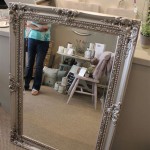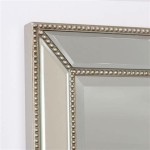Choosing the Right Mirror for Your Room: A Comprehensive Guide
Mirrors are more than just reflective surfaces; they are powerful design elements that can significantly impact a room's aesthetic, spatial perception, and overall ambiance. Selecting the appropriate mirror requires careful consideration of several factors, including size, shape, style, and placement. This article will delve into these considerations to provide a comprehensive guide for choosing the right mirror for any room in your home.
Mirrors serve multiple purposes beyond personal grooming. They can visually expand a space, making small rooms appear larger and more open. They also enhance natural light by reflecting existing illumination, brightening dark corners and reducing the need for artificial lighting. Furthermore, mirrors can act as focal points, drawing the eye and adding visual interest to a room's decor. Choosing the correct mirror involves understanding these potential benefits and tailoring the selection to the specific needs and characteristics of the room.
Key Point 1: Size and Shape Considerations
The size and shape of a mirror are crucial determinants of its impact on a room. A mirror that is too small can appear insignificant and lose its visual impact, while a mirror that is too large can overwhelm the space and create an unbalanced aesthetic. The ideal size should be proportionate to the wall it occupies and the furnishings around it.
For example, when selecting a mirror to hang above a console table, the mirror's width should generally be no wider than the table itself and ideally, about two-thirds of its width. The height should also be proportional, ensuring that the mirror doesn't dwarf the table or appear too small and insignificant. This balanced approach ensures a harmonious visual relationship between the mirror and the furniture below.
Shape also plays a significant role in shaping the room's character. Rectangular mirrors are a classic choice, offering clean lines and a sense of formality. They are well-suited for hallways, bathrooms, and bedrooms, where they can elongate walls and create a sense of spaciousness. Round mirrors, on the other hand, add a touch of softness and elegance to a room. Their curved lines can soften harsh angles and create a more inviting atmosphere. They are often used in living rooms, dining rooms, and entryways to add a decorative flair.
Oval mirrors offer a blend of both rectangular and round shapes, providing a balanced and versatile option. They can be used in various settings, adding a touch of refinement without being overly formal. Asymmetrical shapes present a more contemporary and artistic choice, perfect for adding a unique and unexpected element to a room. These unconventional shapes can serve as conversation starters and focal points, injecting personality into a space.
Floor-length mirrors, also known as cheval mirrors, are particularly effective for creating the illusion of greater height. They can dramatically transform a small room by reflecting the entire space, creating a sense of depth and openness. They are commonly placed in bedrooms or dressing areas, providing a full-body reflection for getting ready.
Key Point 2: Style and Frame Selection
The style of the mirror should complement the existing design scheme of the room. A mirror with an ornate, gilded frame might be perfect for a traditional or Victorian-style room, while a minimalist, frameless mirror would be more suitable for a contemporary or modern space. The frame material also contributes to the overall aesthetic; wood frames add warmth and a natural touch, while metal frames offer a sleek and industrial look.
Consider the color palette of the room when selecting a mirror frame. A mirror with a frame that matches or complements the existing color scheme will create a cohesive and harmonious look. Conversely, a mirror with a contrasting frame can serve as a bold accent, adding a pop of color or visual interest to the room.
Frameless mirrors are often favored for their clean and understated aesthetic. They seamlessly blend into the background, making them ideal for small spaces where a bulky frame might overwhelm the room. They also work well in minimalist designs, where the focus is on simplicity and functionality. These mirrors typically feature polished edges for a clean and safe finish.
Beveled mirrors add a touch of sophistication and elegance. The angled edges create a subtle visual effect, catching the light and adding depth to the mirror's surface. Beveled mirrors are a classic choice for bathrooms and dressing areas, where they can add a touch of luxury. The beveling process involves grinding and polishing the edges of the mirror at an angle, creating a decorative edge that refracts light.
Antique mirrors, with their aged and distressed finishes, add a touch of character and history to a room. They are often used in eclectic or vintage-inspired designs, adding a unique and nostalgic element. The imperfections and subtle variations in the glass create a sense of authenticity and charm. These mirrors often feature ornate frames and details, reflecting the craftsmanship of past eras.
Key Point 3: Placement and Lighting Considerations
The placement of a mirror is just as important as its size and style. Strategic placement can maximize its reflective properties and create the desired visual effect. Placing a mirror opposite a window, for example, will amplify natural light and brighten the room. Mirrors can also be used to reflect interesting architectural features or artwork, creating a sense of depth and visual interest.
Avoid placing mirrors in areas where they might reflect clutter or unsightly views. This can create a sense of visual chaos and detract from the overall aesthetic of the room. Instead, position mirrors to reflect positive elements, such as greenery, artwork, or a well-designed furniture arrangement. This will enhance the room's beauty and create a more harmonious atmosphere.
Lighting plays a crucial role in maximizing the effectiveness of a mirror. Poor lighting can render a mirror ineffective, while well-placed lighting can enhance its reflective properties and create a flattering effect. Consider the existing lighting in the room when determining the best placement for your mirror.
In bathrooms, mirrors are typically placed above the vanity, with lighting fixtures positioned on either side or above the mirror. This provides ample illumination for grooming tasks and ensures a clear and even reflection. Sconces mounted on either side of the mirror offer a balanced and flattering light, while overhead fixtures provide general illumination for the entire bathroom.
In living rooms, mirrors can be used to reflect ambient light from lamps or natural light from windows. Placing a mirror near a light source will amplify the light and create a warmer, more inviting atmosphere. Avoid placing mirrors directly in front of harsh or unflattering light sources, as this can create glare and distort the reflection.
In hallways, mirrors can be used to brighten narrow spaces and create a sense of depth. Placing a mirror at the end of a hallway will make it appear longer and more spacious. Consider adding a small table or console beneath the mirror to create a functional and stylish entryway.
When positioning a mirror, consider the viewing angle. The mirror should be placed at a height that allows for comfortable and natural viewing. In bathrooms, the bottom edge of the mirror should typically be positioned a few inches above the sink. In bedrooms, floor-length mirrors should be placed at a distance that allows for a full-body reflection.
Finally, always ensure that the mirror is securely mounted to the wall. Use appropriate hardware and follow the manufacturer's instructions to prevent accidents. For heavy mirrors, consider hiring a professional installer to ensure a safe and secure installation.
By carefully considering these factors – size and shape, style and frame, and placement and lighting – one can select the perfect mirror to complement any room and enhance its overall aesthetic appeal. The correct mirror can transform a space, adding light, depth, and visual interest, making it an invaluable design tool for creating a beautiful and functional home.

The Art Of Living With Exceptional Mirror Design Accent

Bedroom Mirror Collection Wall Mirrors

Decorative Wall Mirrors 40 Design Catalogue For Living Room Hallway Bathroom

Buy Best Dressing Table Mirrors Glazonoid

Inspiration Mirrors Glamourous Bedroom Elegant Design Luxurious Bedrooms

25 Mirror Decor Ideas From Designer Rooms

Bedroom Mirror Ideas Mirrors Design Decor And Placement Fab Glass

34 Popular Mirror Wall Decor Ideas Best For Living Room Wanddekor Schlafzimmer Wohimmer Spiegel Schöne

16 Best Bedroom Wall Mirror For Your Interior In 2024 Accent

Mirror Wall Panel Ideas To Elevate Your Living Space








